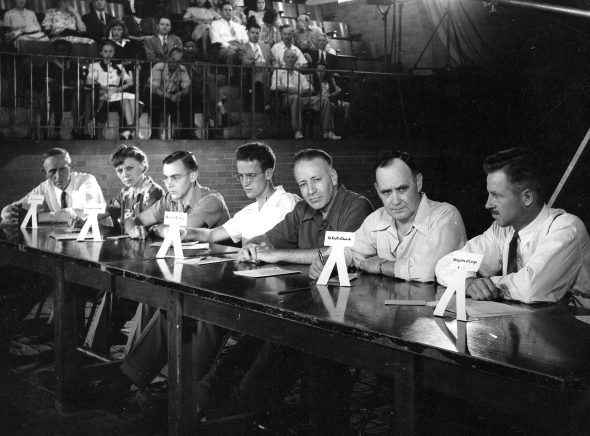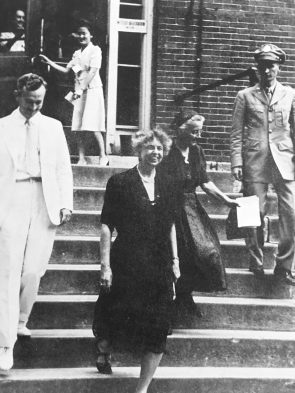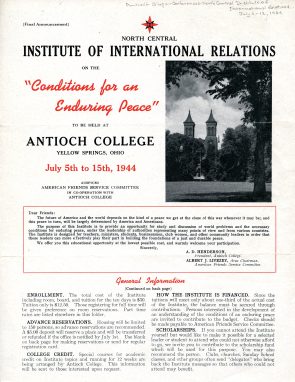
Delegates representing local institutions and organizations at the Yellow Springs Peace Conference meeting in the gymnasium of John Bryan High School, July 1943. (Photo by H. Lee Jones, courtesy of Antiochiana, Antioch College)
Little Peace Conferences envision post-war peace
- Published: February 15, 2023
The following article appeared in the 2021–22 Guide to Yellow Springs: A Kaleidoscopic View of the Village. Click here to read more articles from that year’s guide.
By Scott Sanders
At a time of war, a small Ohio village and the college within it also thought of peace. These thoughts focused on how things should be once the Second World War ended and to be ready for it when it was over.
Postwar planning for the village of Yellow Springs started with local veterans of the First World War, notably playwright Harold Igo and restaurateur Bill Pohlkotte. Both men had come home to a United States completely unprepared for the return of nearly five million soldiers, and both had experienced privation and unemployment as a result.

First Lady of the United States Eleanor Roosevelt and Antioch College President Algo D. Henderson exit Antioch’s Main Building during Mrs. Roosevelt’s visit to campus to address The Postwar Reconstruction Conference, July 1944. (Photo by Professor of Physics Gwilym Owen, courtesy of Antiochiana,
Antioch College)
Thought became action in the summer of 1943 and formalized in a landmark event called The Little Peace Conference. The proceedings began as they so often seem to in a small town (stereotypically, anyway): with a parade. Held over the course of four consecutive Sundays (the last session on the 4th of July), the conference was chaired by the Village Mayor, Lowell Fess (Antioch College class of 1915), also a veteran of WWI.
Delegations formed to represent local institutions (churches and the College), organizations (the Civic and Cooperative Clubs and the League of Women Voters), and constituencies (Rural Community and Organized Labor) and public meetings were held in the auditorium of the John Bryan Center, then still the high school.
The Attorney General for the State of Ohio and the Chief Justice of the State Supreme Court provided opening remarks, but most of the floor time went to local residents. Former Antioch College president Arthur E. Morgan followed with a speech entitled “The Community Design,” setting the stage for the postwar planning sessions to come. Two days were devoted to discussions on Public Works and Improvements and one to Social Services.
The PR for the Little Peace Conference was the “viral video” of its day. Willard Van Dyke of the Overseas Film Bureau, a division of the Office of War Information (OWI), was on hand for the closing session to consider the possibilities of international publicity for the conference using motion pictures. Van Dyke saw the LPC as the perfect vehicle to dispel prevailing notions abroad that the United States would return to its prewar isolationist traditions. As these things take time, a camera crew of 12 filmed reenactments of the conference about a month later along with scenes about town. Harold Igo, recognized founder of the conference, authored the script for the production, a two-reel short entitled “More Than A Parade” that the OWI translated into 28 languages for distribution around the world.
While the original goal of guaranteeing employment for returning service members was not entirely achieved, some significant progress was made in other areas, most importantly in the far-reaching decision to adopt the city manager form of government for the village, which is still in place.
In addition, the delegates drew up a charter for the conference in the name of the 250 villagers then in military service, committing themselves “to a better Yellow Springs” with the creation of a Permanent Planning Board, still a distinctive feature of Village government now known as Planning Commission.
Finally, the charter pledged a four-point policy “to favor freedom from class, creed, and race prejudice … to provide our young people with opportunity for self-development and productive careers at home … to be a good neighbor to other communities and to play our part in the development of the new world …[and] to make our community more liveable for our returning service men.”
Historically often ahead of the curve, Antioch College hosted its first conference on the postwar world even before the United States entered World War II. The graduates of the Class of 1940 decided to have substantive discussions about the future as part of their commencement exercises. It was a fairly modest beginning for an annual run of much larger conferences on campus 1943–48 sponsored by the Institute of International Relations, a branch of the American Friends Service Committee.
Known collectively as the Postwar Reconstruction Conferences, it was the AFSC series that brought the heaviest of heavy hitting speakers to campus, headlined by the First Lady of the United States, Eleanor Roosevelt, in the summer of 1944. Also on hand that year were Pulitzer Prize-winning author Pearl Buck and perennial Socialist Party presidential candidate Norman Thomas.
Subsequent conferences boasted such prominent figures as diplomat Ralph Bunche, the first African American to win the Nobel Peace Prize in 1950, U.S. delegate to the United Nations Dorothy Kenyon, economist and pacifist Scott Nearing, Chicago newspaper publisher Marshall Field, and two founding members of the Communist Party of the United States — Bertram Wolfe and Lewis Corey.
Another heavy hitter from another time, Coretta Scott King (class of 1951), was an Antioch College undergraduate in 1947 when she heard pioneering civil rights organizer and activist Bayard Rustin, then with the Fellowship of Reconciliation, address the 1947 conference with a speech called “Old and New Armor,” a moment she recalled in her memoirs as life-changing. She thenceforth committed herself to nonviolent social action for which she and her future husband Dr. Martin Luther King, Jr. became best known.
*Sanders is the archivist at Antiochiana, Antioch College.
One Response to “Little Peace Conferences envision post-war peace”
The Yellow Springs News encourages respectful discussion of this article.
You must login to post a comment.
Don't have a login? Register for a free YSNews.com account.














A friend recently sent me a downloadable video of “Conference At Yellow Springs “ an old grainy black & white video with a duration of 10:28. It wasn’t the actual “Little Peace Conference” video. YS residents are discussing the possibility of starting a peace conference in Yellow Springs for the young soldiers return from WW2.
The film was produced by Office Of War Information Overseas Branch.
I am trying to determine the date (or even the year) that this short film was made.
Any information as to the year would be much appreciated. Thanks